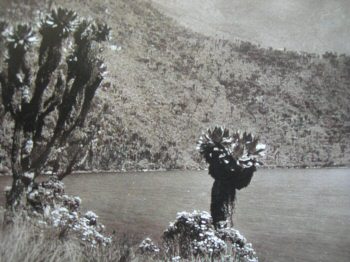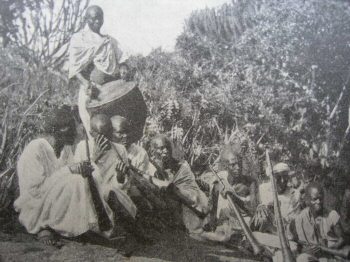|
History of the Climbing
before 1906
It was necessary
to wait until 1888 before having certain information
about the existence of the Mountains of the Moon. On
May 24th of that year, the famous English journalist-explorer,
Henry Stanley, finally succeeds in glimpsing
the snow-capped peaks of the Rwenzori, as he travels
along the coastal plain southwest of Lake Albert.
As a matter of fact Stanley is not the first person
to sight the great snow-covered mountains, which are
shortly to be known as the Rwenzori. During the preceding
years, in different circumstances and periods, Samuel
Baker and Romolo Gessi had succeeded in catching a glimpse
of great mountainous masses away in the distance, to
the south of Lake Albert.
However the fogs and mists from the low lands obscured
and confused their form and profiles to the point of
transforming them into a vision of something unreal,
similar to a hallucination or mirage. As far as he is
concerned, Stanley is absolutely certain that the great
mountains on the horizon are Ptolemy's Lunae Montes.
Indeed, of all the peaks scattered round the middle
of equatorial Africa, only the ice-capped summits of
the Rwenzori correspond to the ancient's descriptions.

Lake Kitandara by Vittorio Sella
In any case, his discovery throws new light on the geography
of the region. Not only: it also confirms, quite remarkably,
the tenacious tradition which sees the Nile rising from
the Great Lakes fed by snow-covered mountains. In a
word the image dear to Aeschylus of an "Egypt nourished
by snows", returns to being an extraordinary relevance
to the present day. Henry Stanley is once again in the
Rwenzori area the following year, 1899, and travels
along the Western flank of the mountainous group.
Between spring and summer he remains for a long time
in the vicinity the range, and from time to time succeeds
in catching sight of some the higher snow-capped peaks.
Eager to get on closer terms with the mountains of the
moon, he instructs is deputy W.G. Stairs to
carry out a short explorative trip to the heart of the
imposing relief. From Bakokoro camp Stairs ascends one
of the valley to the North-West of the range for two
days, aiming towards two characteristic rocky peaks.
He advances to altitudes 3254, about 500 meters below
the two peaks and from up there he manages to observe
a snow-capped summit which he believes to be higher
than 5000 meters and which, however, does not seem to
be the highest of the group. Ill-equipped for a long
stay at high altitude, Stanley's deputy quickly retraces
his steeps, returning with the idea that the Rwenzori
group is of volcanic origin. He is wrong. In the following
years other attempts at exploration are registered.

Baganda Musicians photo by Vittorio Sella
In June 1891 F. Stuhlmann, following
on Emin Pasha's expedition, ventures for five days into
the upper Butagu valley, one of the most important on
the western side of the range. He reaches 4036 meters,
in the sight of two snow-capped peaks, and is then obliged
to turn back. On his return he relates the succession
of the various phases of vegetation with an abundance
of details, but above all he describes the Rwenzori
as a real mountain range, composed of four principal
groups, and certainly not of volcanic origin.
A new explorative impetus in the area takes place in
the years 1894 to 1895, carried out by the naturalist
G.F. Elliot who makes five reconnaissance
trips in the five different valleys (the first four-
Yeria, Wimi, Mobuku and Nyamwamba-on the eastern slope,
and the last - Butagu- on the western one). He reaches
a maximum of 3962 meters in the Butagu valley but he
is able to gather any data about the high altitude regions.
Instead, his geological observations on the signs of
old glaciations in the area are very useful. Then, for
five long years the Rwenzori continues to drowse undisturbed.
Social tensions and problems within the British Colony
in Uganda steer interest for the mountains elsewhere.
Exploration of the great African relief starts up again
in the spring of 1900 with C.S. Moore, head of a scientific
expedition working in the area of the Great Lakes. With
a few Swahili explorers and some indigenous people Moore
ascends the whole Mobuku valley reaching right up to
the terminal crest, at altitude 4541.
During his visit to the Rwenzori, the British explorer
succeeds in demonstrating the presence of true glaciers
(and not the simple snowy accumulations as had been
thought up to that moment). Few weeks later another
two excursions at high altitude are registered: the
first by Ferguson, a member of Moore's expedition; the
other by a certain Bagge, a civil servant from the mining
district of Toro.
Finally, in September, Sir Harry Johnston,
a high commissioner of the English colony in Uganda,
with two companions ascends the Mobuku Valley right
up to altitude 4520, without however managing to reach
the crest.
The high commissioner also succeeds in taking some good
photographs of the valley and in compiling an accurate
description of the mountain vegetation and fauna. An
important detail: Sir Johnston, just like his predecessors,
cannot but mention the constant appalling weather, which
scourges the area.
A continual stream of visitors, all convinced of being
able to throw light on the topography of Rwenzori, appear
during the immediately successive years. In August 1901,
W. H Wylde and Ward climb to the same
altitude reached previously by Moore. Two years later,
Reverend A. B. Fisher and his wife
go as far as the point that Sir Johnston reached. Then,
in 1904, the newspaper Globus carries news of another
climb. A short report states that J. J David had reached
an altitude of 5000.
The first, real, mountaineering attempt of the Rwenzori
belongs to a year later, November 1905. William
Douglas Freshfield and Arnold Louis
Mumm arrived at the Mobuku Valley together
with the Alpine guide Moritz Inderbinnen from Zermatt.
Ferment around the Rwenzori continues to increase. Only
a month earlier, in October, a scientific expedition
from the British Museum left London, led by A.B. Woosnam.
G. Legge, R.E. Dent, M. Carruthers and the mountaineer
A.F.R. Wollaston make up part of the
group.
And that is not all. In January 1906 Reverend Fisher
and his wife return for a second time to the Mobuku
glacier. And an Austrian mountaineer, R. Grauer,
together with two British missionaries, H.E Maddox and
H.W. Tegart, who had already been on the glacier the
preceding yera, reach the crest which closes the valley,
not climbed since 1901, and scale a rocky pinnacle,
the King Edward Peak.
Meanwhile the English expedition reaches Mobuku Valley.
First Woosnam, and then a small group of explorers made
up of Wollaston, Dent and fhe same Woosnam, climb to
the point already reached by Grauer. Afterwards, Woosnam
and Wollaston attempt to climb Kiyanja [Stuhlmann's
Seper,today Mount Baker]. Because of the fog they have
to stop below the summit at an altitude estimated at
4915 metres.
Then, on April 1st, Woosnam, Wollaston and Carruthers
reach a peak 4844 metres high which dominates the valley
to the north-east; they think it is Johnston's Duwoni.
At the end, three days later, the roped party returns
to the rocky pinnacle of Kiyanja, which, on a second
measuring results higher: 4992 metres.
After Stuhlmann's observations, it is common belief
that the Ruwenzori are made up of four main mountain
groups; nevertheless it is not known if these are if
these are connected to each other or separated by valleys
or valley systems. Besides, the altitude of the main
peaks is subject to divese hypotheses, which go from
5000 to over 6000 metres; but, who knows, there could
be even higher peaks still to be discovered.
From “The
Rwenzori Discovery- Luigi Amedeo di Savoia Duca degli
Abruzzi”, by Roberto Mantovani, Museo Della
Montagna 1996.
|